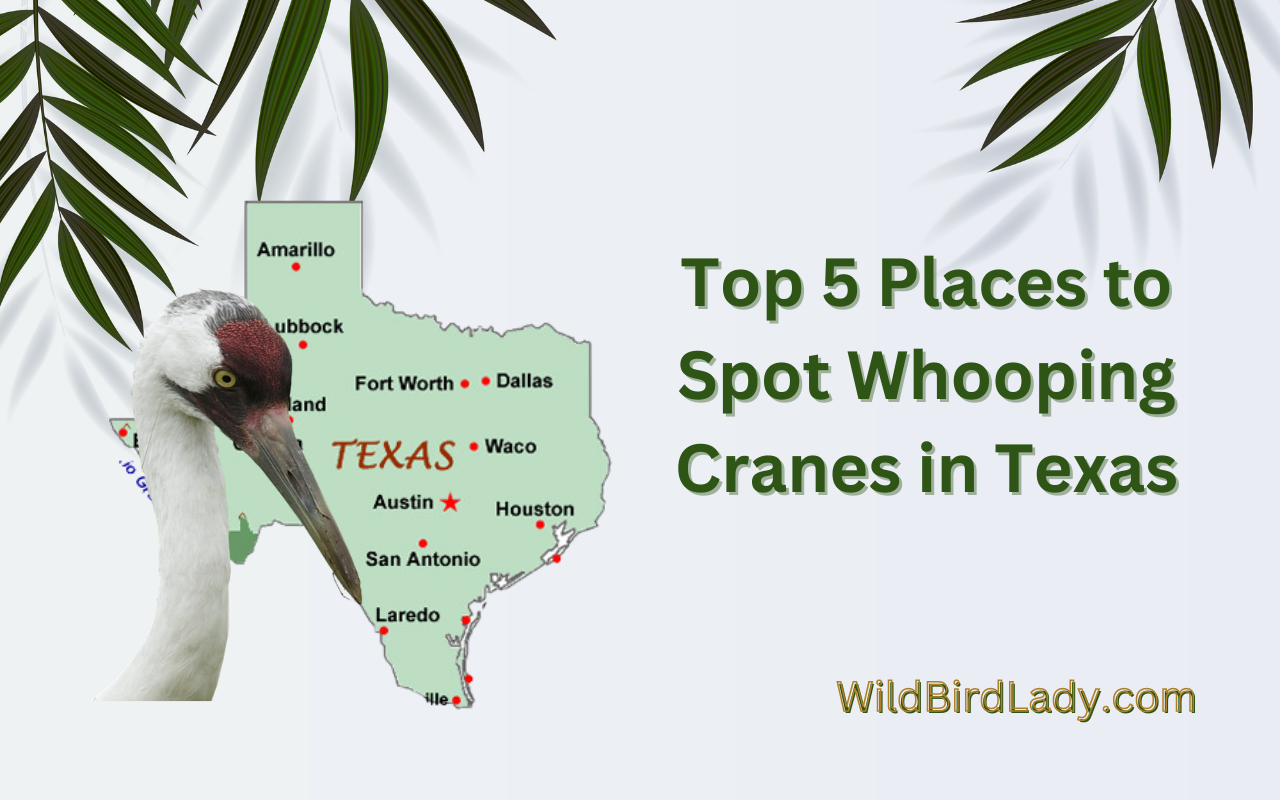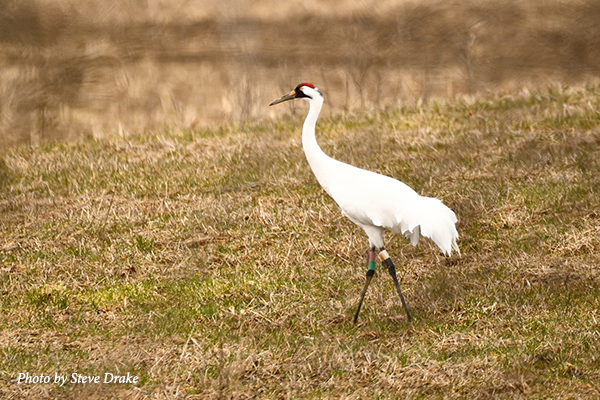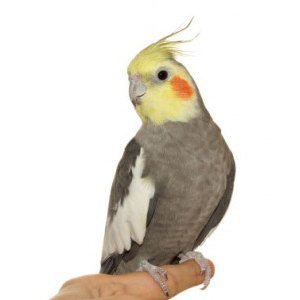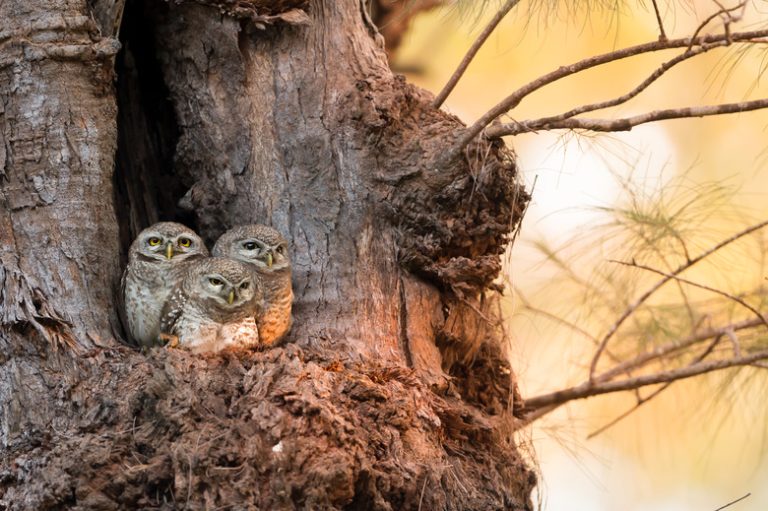Top 5 Places to Spot Whooping Cranes in Texas
The top 5 places to spot whooping cranes in texas are aransas national wildlife refuge, matagorda island wildlife management area, welder flats, goose island state park, and port aransas. Whooping cranes, north america’s tallest bird and among the rarest in the world, migrates to texas every year from their summer breeding grounds in canada’s wood buffalo national park.
It’s a unique opportunity to observe these magnificent birds during their long journey south. While the birds are observed throughout the state, the top 5 places to spot them provide the best viewing opportunities. These locations offer a variety of viewing possibilities, including walking trails, observation decks, and even boat tours.
Whether you’re an experienced birdwatcher or a nature enthusiast, these spots are an absolute must-see during your visit to texas.
Importance Of Spotting Whooping Cranes In Texas
Ecological And Conservation Importance Of Whooping Cranes
The tallest bird in north america, whooping cranes are unique and magnificent. They play a significant role in the united states’ ecological and conservation systems. Here’s a rundown of their ecological and conservation importance:
- Whooping cranes distribute seeds and plants in their habitat, aiding in plant regeneration.
- They influence invertebrate and plant ecology, which can impact the food chain of wetland environments.
- Whooping cranes have cultural and spiritual importance amongst the native american communities of north america.
Significance Of Texas As A Natural Habitat For Whooping Cranes
Texas is an important habitat for whooping cranes due to the following reasons:
- The state has an extensive network of wetland habitats, providing a suitable area for breeding and migrating whooping cranes.
- The aransas national wildlife refuge, situated on the gulf of mexico, serves as the only rehabilitation spot for a self-sufficient migratory population of whooping cranes.
- Approximately two-thirds of the migrating whooping crane population travels through texas on their migratory route.
Importance Of Spotting Whooping Cranes In Texas For Conservation Efforts
Whooping cranes’ survivability as a species depends on its population size. Spotting whooping cranes can be instrumental in supporting conservation efforts in texas. Here are some points to consider:
- Citizen-led sightings provide valuable data for understanding the population size and distribution of whooping cranes, which can inform conservation plans.
- The endangered species act provides protections for whooping cranes, and accurate surveys help ensure its safety.
- As an endangered species, conservation efforts for whooping cranes draw attention to wetland environments’ protection and restoration, which would additionally benefit other species that use these environments.
Spotting whooping cranes is essential to ensure their survival as a species. It can also help support wetland environments and other species that depend on them. As a citizen, you can join conservation efforts by sighting and reporting any sightings of whooping cranes in texas.
Aransas National Wildlife Refuge
If you’re a birdwatcher, one of the must-visit places on your list should be the aransas national wildlife refuge in texas. This protected area has become a sanctuary for various bird species, including the endangered whooping crane. Here are some tips on how to spot these majestic birds in their natural habitat – the aransas national wildlife refuge.
Introduction To Aransas National Wildlife Refuge
The aransas national wildlife refuge lies on the coastal bend of texas, protecting over 115,000 acres of grasslands, wetlands, and oak-juniper forests. Its prime location along the central flyway, a migration path for birds from the arctic to south america, makes it a hot spot for birdwatchers.
Bird enthusiasts flock from around the world to spot some of the 400 species that call the refuge home, including the magnificent whooping cranes.
Ideal Time To Visit The Refuge
The best time to visit the aransas national wildlife refuge is during the winter season, from mid-october to early april. This is the peak migratory season for the whooping cranes, as they make their way from wood buffalo national park in alberta, canada, to their wintering grounds in the texas coast.
Additionally, the spring season, from late april to early june, offers a chance to see the whooping crane chicks, as they hatch and grow under the watchful eyes of their parents.
Here are some essential tips to keep in mind when planning your trip to the refuge during peak season:
- Plan your visit ahead of time and book your tickets early. The official website of aransas national wildlife refuge provides information on ticket availability, reservations, and fees.
- Avoid visiting the refuge during the weekends, as it tends to get crowded with visitors. Instead, plan your visit during the weekdays to enjoy a more peaceful birdwatching experience.
- Dress appropriately for the weather, as winters can be cold and windy on the texas coast. Bring sturdy footwear, warm clothing, and a hat or beanie to protect your head and ears from the cold.
Best Spots To Spot Whooping Cranes In Aransas National Wildlife Refuge
The aransas national wildlife refuge offers plenty of opportunities to spot whooping cranes in their natural habitat. Here are some of the best spots to increase your chances of seeing these majestic birds:
- The heron flats observation tower: This 40-foot tower provides an unobstructed view of the surrounding wetlands, where whooping cranes are often spotted feeding and roosting. The tower is wheelchair accessible and offers a panoramic view of the refuge.
- The whooping crane trail: This 0.7-mile trail leads visitors to a viewing platform near the marsh, where whooping cranes can be seen foraging for food. The trail is an easy walk and is suitable for all ages.
- The fennessey ranch boat tour: This two-hour boat tour takes visitors through the heart of the aransas national wildlife refuge, allowing them to see whooping cranes up close. The tour is led by experienced guides who provide insight into the birds’ behavior and habitat.
- The skimmer boat tour: This guided boat tour takes visitors to remote areas of the refuge, where whooping cranes are often found feeding and resting. The tour is conducted on small boats, providing an intimate and immersive experience for birdwatchers.
- The big tree viewing area: This scenic area provides a view of the big tree, a 1,000-year-old live oak, and a popular roosting site for whooping cranes. Visitors can walk along the boardwalk to get a closer look at the enormous tree and the birds that call it home.
Whether you’re an experienced birdwatcher or a beginner, the aransas national wildlife refuge is the perfect place to spot the endangered whooping crane. With its diverse habitat and prime location, the refuge offers an unparalleled birdwatching experience that is sure to leave you in awe.
Best Spots To Spot Whooping Cranes In Aransas National Wildlife Refuge
If you crave the sight of unique and majestic birds in their natural habitat, head to aransas national wildlife refuge in texas. It is renowned for its conservation efforts, allowing visitors to witness endangered whooping cranes in their natural setting.
Here are the top spots for spotting these amazing creatures:
Detail The Best Viewpoints For Spotting Whooping Cranes
- Hermit trail offers expansive views of the marshes that the whooping cranes frequent. You can view them with a scope or binoculars from the site’s viewing platforms.
- Big tree trail is another good viewpoint. With the crane’s enormous footprint, easily spotted from the long, wooden boardwalk. In addition, visitors have a clear view of the many songbirds and wading birds present in the marshy landscape.
- The 40-acre wood overlook is a remote viewing platform by the road that provides a perfect vantage point for witnessing whooping cranes in flight. Visitors come during the busiest times of the day since this platform is often filled up. However, it’s worth the effort because the experience of seeing the cranes soar through the sky is breathtaking.
Discuss Behaviors And Physical Features Of Whooping Cranes That Visitors Should Observe
As the tallest north american bird, the whooping cranes stand nearly 5 feet tall. They have a white body with a red cap and a black bill and legs. Observers should beware of their seven-foot wingspan. Visitors to the refuge may catch sight of pairs engaging in a graceful dance known as the ‘unison call’.
Another notable behavior is their distinct ‘whooping’ sounds, which can be heard from miles away. Make sure to capture some excellent pictures of them, but be sure not to get too close, as they are still at risk of becoming extinct.
Goose Island State Park
Goose island state park is known for its stunning landscapes, abundant wildlife, and particularly for being a paradise for birding enthusiasts. This park, located on the central coast of texas, is indeed a major destination for those seeking to spot the impressive whooping cranes.
Introduction To Goose Island State Park
Goose island state park is a popular tourist destination and a bird-watcher’s haven. The park offers a diverse range of habitats, including wetlands, prairies, and woodlands – all providing excellent opportunities to explore texas’s natural beauty. With so much to offer, it’s an ideal place for those seeking a peaceful and serene escape.
Unique Features Of The Park
- The park is located on the coast of texas, providing an ideal habitat for whooping cranes.
- The park offers over 300 species of birds, making it an excellent destination for birding enthusiasts.
- The park provides opportunities for fishing, boating, and kayaking, making it an ideal place for exploring texas’s natural beauty.
- The park has several historical landmarks, including the famous century tree, a live oak over 1,000 years old.
Best Spots To Spot Whooping Cranes
Goose island state park provides plenty of opportunities for visitors to view whooping cranes. Here are some of the best spots to catch a glimpse of these magnificent birds:
- Big tree trail: This trail offers a great view of the marshlands of st. charles bay, providing an excellent spot for observing whooping cranes.
- Shoreline trail: The shoreline trail leads visitors along the park’s bay and provides an excellent opportunity to spot the whooping cranes.
- Heron flats trail: This trail passes through the park’s wetlands and provides excellent opportunities to spot a variety of bird species.
- Observation tower: Located near the rv camping area, this tower provides panoramic views of the park and a perfect spot to see whooping cranes.
- The docks: The park has several docks and piers along the waterfront. These areas provide an opportunity to spot whooping cranes near the water.
Goose island state park is indeed a birdwatcher’s paradise, and with these tips, visitors are sure to have an excellent experience spotting one of the rarest birds in texas.
Best Spots To Spot Whooping Cranes In Goose Island State Park
Goose island state park in texas is one of the best places to spot the endangered whooping cranes during the winter migration season. Make sure you bring your binoculars and camera to capture the majestic beauty of these birds and the stunning surroundings.
Here are the top tips for spotting whooping cranes in goose island state park.
Detail The Hiking Trails That Offer The Best Proximity To Whooping Cranes
Goose island state park has several wonderful hiking trails that offer an opportunity to see whooping cranes up close. Here are the best hiking trails to spot whooping cranes:
- Big tree trail: Take a leisurely walk through the live oak canopy and marshlands to reach the park’s famous big tree, the largest coastal live oak in texas and a good spot to look for whooping cranes.
- Fishing pier trail: Enjoy the stunning views of st. charles and aransas bays while you look for whooping cranes on the fishing pier.
- Lantana loop trail: This trail is a little more challenging, but it offers great bird-watching opportunities in addition to the chance to see whooping cranes.
Discuss The Best Time Of Day To Visit The Park For Optimal Chances Of Spotting Whooping Cranes
The best time to spot whooping cranes in goose island state park is early in the morning or late in the afternoon. Here’s why:
- Early morning: Whooping cranes usually feed in the morning just after dawn, so getting to the park early will increase your chances of spotting them.
- Late afternoon: In the late afternoon, the whooping cranes begin to return to their roosting areas, allowing for another great opportunity to see them.
Make sure you plan your visit to the park keeping this in mind to maximize chances of spotting whooping cranes.
Overall, goose island state park is a fantastic destination for bird watchers and nature lovers alike, with plenty to see and do. With these tips, you can increase your chances of spotting the incredible whooping cranes during your visit.
Matagorda Island Wildlife Management Area
Matagorda island wildlife management area represents a wildlife oasis in texas for bird lovers and native species. The land is home to a diverse population, including one of the rarest birds in north america – whooping cranes. If you’re looking to spot whooping cranes in texas, this area is a must-visit.
In this section, we’ll explore everything you need to know about matagorda island wildlife management area and what makes it the perfect habitat for whooping cranes.
Introduction To Matagorda Island Wildlife Management Area
Stretching across 56,000 acres, matagorda island wildlife management area lies between the gulf of mexico and lavaca bay. Visitors can explore over 20 miles of beach or hike across the island’s dunes and prairies.
Discuss The Unique Features Of The Area That Make It An Ideal Habitat For Whooping Cranes
Matagorda island wildlife management area is one of the most critical habitats for whooping cranes in the us. Its location, marshes, tidal flats, and prairies provide an ideal range for these rare birds. The area also hosts a diversity of bird and fish species, which whooping cranes prey on.
The management of the area by texas parks and wildlife department ensures that the habitat remains in pristine condition for whooping cranes to thrive.
Detail The Best Spots To Spot Whooping Cranes, Making Sure That Each H3 Heading Adheres To Markdown Syntax ()
Shell Bar Cove
Located on the north-eastern side of the island, shell bar cove provides an excellent viewing platform for whooping cranes. Shell bar cove is known for its shallow waters and tidal flats, which provide feeding opportunities for whooping cranes.
Dagger Island
Located in the central part of matagorda island, dagger island is one of the more isolated spots. It’s accessible only by boat or trekking to the inner coastal waters. This area allows for unobstructed views of the whooping cranes, which is perfect for photography and birdwatching enthusiasts.
Big Bayou And Big Slough
Big bayou and big slough, located on the island’s northwest side, offer a unique opportunity to spot whooping cranes. These areas have a significant concentration of waterfowl, including whooping cranes, and provide excellent feeding grounds for the birds.
South Texas Coastal Preserve
South texas coastal preserve is situated south of the island and is accessible via boat. It’s a vast area that extends almost 78,000 acres. Visitors to south texas coastal preserve can also spot other bird species, including the endangered reddish egret, roseate spoonbill, and white-tailed kite, among others.
The Best Time To Visit Matagorda Island Wildlife Management Area
To witness the whooping cranes, we recommend visiting matagorda island wildlife management area between november and april. During this period, the whooping cranes have migrated south to avoid harsh winter conditions. Besides, these months provide the perfect weather conditions, with cool and pleasant temperatures.
Matagorda island wildlife management area offers visitors the opportunity to spot north america’s rarest bird species. As we’ve seen, the area’s unique features such as marshes, tidal flats, and prairies make it an excellent habitat for whooping cranes. Exploring the island’s beaches, hiking trails, and spots like shell bar cove, dagger island, big bayou and big slough, and south texas coastal preserve offers visitors the perfect opportunity to experience the magic of this unique habitat.
Best Spots To Spot Whooping Cranes In Matagorda Island Wildlife Management Area
If you’re searching for a place to spot the magnificent whooping cranes in texas, then matagorda island wildlife management area should definitely be on your list. Nestled along the gulf coast, it boasts a diverse ecosystem that provides a perfect home for the rare cranes.
Here are the best spots to spot them and what to look out for when you visit:
Detail The Best Viewpoints For Spotting Whooping Cranes
- Mule deer trail: This trail passes through a habitat area that the whooping cranes love to frequent- the salt marshes. It is also a favorite spot for birdwatchers because of the strategic viewpoints that overlook the marshes.
- Jetty park: Positioned at the tip of matagorda island, this park overlooks the bay and is a great place to observe the whoopers as they gather to roost and feed at dawn or dusk.
- Birding loop: This roadway winds its way through the island’s diverse landscape, providing you with multiple viewing vantage points.
Observing The Behaviors And Physical Features Of Whooping Cranes
- Recognizing whooping cranes: These majestic birds are tall, standing at over four feet, with a wingspan that reaches seven feet! They have long, skinny legs that allow them to wade through shallow water while they feed. Their distinctive red crown, white feathers, and black wingtips make them easy to differentiate from other bird species.
- Mating and courtship: Whooping cranes mate for life and will often be found in pairs. Their mating rituals include calling, head-bobbing, and jumping. Visitors can observe these courtship behaviors, particularly in the mating season (february-april).
- Feeding habits: Whooping cranes enjoy a diet of insects, small crustaceans, fish, and aquatic plants. They forage while walking, and their preference for shallow water habitats means they can be spotted foraging in the marsh fields at low tide.
Matagorda island wildlife management area is the best spot to catch a glimpse of the impressive whooping cranes in texas. With strategic viewpoints and opportunities to observe their unique behaviors and physical features, it’s a birdwatchers’ haven. Make sure to add this location to your list of must-visit sites when you’re next in texas.
Lamar Peninsula
A hidden gem of texas, the lamar peninsula is one of the best places to spot whooping cranes. With its unique eco-system and natural reserves, the peninsula remains a favorite destination for bird enthusiasts across the globe. Let’s explore why lamar peninsula is a paradise for bird lovers and where to spot them with the following h3 headings:
Introduction To The Lamar Peninsula
Located on the eastern coast of texas, the lamar peninsula stretches across 90 miles, separating the aransas bay from the gulf of mexico. Though less popular than other destinations in texas, the region boasts a diverse ecosystem, providing a natural habitat for a wide range of creatures, including whooping cranes.
Discuss The Unique Features Of The Peninsula That Make It An Ideal Habitat For Whooping Cranes
The following are the unique features of lamar peninsula that make it an extraordinary habitat for whooping cranes:
- Shallow waters: The bays and wetlands surrounding lamar peninsula are shallow and brackish, providing an ideal place for whooping cranes to feed and roost.
- Incredible flora and fauna diversity: The area has a diverse range of trees, shrubs, and marshes, which form a nurturing environment for many species of bird and wildlife.
- Protected reserves: Lamar peninsula is home to several private and public reserves, which protect the fragile ecosystem and provide a sanctuary for wildlife, including whooping cranes.
- Migration destination: As a vital stop on the migratory route between canada and mexico, lamar peninsula remains a crucial breeding and feeding ground for whooping cranes.
Detail The Best Spots To Spot Whooping Cranes In The Lamar Peninsula
If you’re looking for the best places to spot whooping cranes in lamar peninsula, check out these bird watching hotspots.
- Aransas national wildlife refuge: A favorite spot for wintering whooping cranes, the refuge provides guided boat tours and observation decks for visitors.
- Goose island state park: Located near the town of rockport, the park offers a scenic setting for bird watchers, with boardwalks, hiking trails, and camping sites.
- Port aransas birding center: Situated at the heart of port aransas, the center includes a boardwalk, observation tower, and bird blinds for visitors to spot whooping cranes and other bird species.
- Mad island marsh preserve: A sprawling nature reserve with diverse habitat, including salt flats, marshes, and oak forests, the area is a favorite destination for serious bird watchers.
- Bay flats lodge: A unique lodge nestled in the heart of louisiana marshlands offers guided fishing and birding tours, providing visitors with a rare opportunity to experience the region’s beauty and wildlife.
Visit lamar peninsula for an unforgettable bird watching experience and make sure to pack your binoculars and camera!
Best Spots To Spot Whooping Cranes In The Lamar Peninsula
As one of the rarest bird species in the world, spotting the majestic whooping crane in texas is a bucket-list experience. The lamar peninsula, located on the texas coast, is a fantastic place to see these endangered birds in their natural habitat.
In this section, we’ll discuss the best spots to spot whooping cranes and what visitors should observe while observing them.
Detail The Best Viewpoints For Spotting Whooping Cranes
The lamar peninsula is one of the few remaining habitats in the world where whooping cranes live and nest. As they are sensitive to human disturbance, there are a few select locations on the peninsula where you can see them without disturbing their habitat.
Some of the best viewpoints for spotting them include:
- The aransas national wildlife refuge covers over 115,000 acres and is home to over 500 species of wildlife. It is one of the most reliable places to view whooping cranes, especially during the peak season from october to april.
- Goose island state park offers visitors a unique opportunity to see whooping cranes in a natural environment. They prefer to roost in the bay-side of the island and can frequently be spotted in the early morning or late afternoon.
- The texas mid-coast national wildlife refuge complex is a network of protected areas along the gulf of mexico. It offers a variety of viewing locations for whooping cranes, including the matagorda island wildlife management area and the welder wildlife foundation refuge.
Discuss The Behaviors And Physical Features Of Whooping Cranes That Visitors Should Observe
Observing the behavior and physical features of whooping cranes can be an unforgettable experience. They are a tall wading bird, reaching up to 5 feet in height and have a wingspan of over 7 feet. Visitors should watch for the following:
- Whooping cranes have a distinctive call that can be heard from far away. They also communicate through various physical gestures, such as head-bobbing and wing-flapping.
- During breeding season, whooping cranes perform elaborate courtship dances, including bowing, jumping, and wing-flapping.
- They feed on a variety of items, such as small fish, crabs, insects, and plants, which visitors may observe while watching them forage.
Whooping cranes are an iconic species of texas and the lamar peninsula is the best place for visitors to observe them. By visiting the suggested viewpoints and paying attention to their habits and features, visitors can experience the magic of this endangered bird.
Rockport
Is a small coastal town located in aransas county, texas, where you can witness the splendor of whooping cranes. These majestic and rare birds are truly a sight to behold. If you’re planning a trip to texas and want to see them, you should definitely add rockport to your itinerary.
Here’s why:
Introduction To Rockport
Rockport is situated near the gulf of mexico, which is a prime location for these birds, especially during their winter migration. It’s home to several protected areas, making it an ideal habitat for whooping cranes. These birds are known for their beauty, unique features, and rarity.
Discuss The Unique Features Of Rockport That Make It An Ideal Habitat For Whooping Cranes
Here are some unique features that make rockport an ideal habitat for the whooping cranes:
- Climate: The climate in rockport is relatively warm, even in the winter. The birds prefer this kind of weather as it allows them to stay warm and conserve energy.
- Food sources: The aransas national wildlife refuge provides a large variety of food sources for these birds. The whooping cranes mainly feed on blue crabs, but other food sources available in the area include clams, shrimp, and fish.
- Protected areas: Rockport is home to several protected wildlife areas, including the aransas national wildlife refuge, making it an ideal sanctuary for the whooping cranes. These protected areas allow the birds to live and breed in peace without the threat of human interference.
- Geography and landscapes: The area surrounding rockport is a perfect combination of marshes, bays, and estuaries, which are essential habitats for whooping cranes. The marshes, bays, and estuaries are all important feeding areas for the cranes and support their ecosystem.
Detail The Best Spots To Spot Whooping Cranes In Rockport
Here are some of the best spots to spot whooping cranes in rockport:
- Aransas national wildlife refuge: This is the most famous and popular place to see the whooping cranes in rockport. The refuge offers numerous observation decks, boardwalks, and tour boats, which allow visitors to see the birds up close.
- Goose island state park: This state park is famous for its campsites, but it’s also an ideal place to spot whooping cranes. The park is home to a boat ramp, fishing pier, along with the big tree, which the whooping cranes like to nest around.
- Fulton mansion state historic site: This is a lovely spot to watch the cranes. The historic site offers expansive views of the surrounding wetlands and marshes, and boardwalks that provide easy access and navigation.
- Port aransas beach: This beach is an excellent viewpoint to see the cranes. The whooping cranes are sometimes spotted around the beach.
- Conn brown harbor: Conn brown harbor is not only a great place to spot whooping cranes but also a perfect location to enjoy sportfishing, kayaking, and boating. Visitors can see many bird species here, including whooping cranes.
Rockport is an excellent place to visit if you want to spot whooping cranes. With its ideal climate, food sources, and protected areas, rockport provides the perfect habitat for these majestic birds. Moreover, the various viewing locations in the area offer tourists and visitors the opportunity to see and learn more about these beautiful birds.
There’s no doubt that visiting rockport will be an unforgettable experience for both nature enthusiasts and bird lovers.
Best Spots To Spot Whooping Cranes In Rockport
If you’re a bird lover, then whooping cranes are something to be excited about. These birds are not just magnificent to look at, but they’re also a symbol of conservation success. If you’re looking for the best spots to spot whooping cranes in rockport, texas, then this post is for you.
Detail The Best Viewpoints For Spotting Whooping Cranes
To see the majestic whooping cranes in all their glory, you need to visit specific places that are best for birdwatching. Here are the best viewpoints for spotting whooping cranes in rockport:
- Aransas national wildlife refuge: This place is a must-visit if you want to spot whooping cranes. The refuge serves as the winter habitat for the only remaining wild population of whooping cranes, making it a key site for crane conservation.
- The big tree natural area: Situated near goose island state park, this natural area provides several observation points for spotting whooping cranes.
- Goose island state park: This park is famous for its birdwatching opportunities, and whooping cranes are among the birds you can spot here.
- Rockport beach: Rockport beach is a beautiful spot for birdwatching, with a boardwalk where you can spot whooping cranes feeding in the marshes during low tide.
- Connie hagar cottage sanctuary: This sanctuary offers a small trail system that leads to the observation deck, where you can see whooping cranes, among other birds.
Behaviors Of Whooping Cranes
Whooping cranes are fascinating creatures with unique behaviors, so knowing what to look for can enhance your birdwatching experience. Here’s what to observe:
- Communication: Whooping cranes communicate through a range of vocalizations and body postures. Pay attention to their calls and how they interact with other cranes.
- Mating dance: If you’re lucky, you might witness the spectacular dance that whooping cranes perform during mating season. The dance involves intricate steps, jumps, and even stick tossing.
- Feeding behaviors: Whooping cranes are omnivores and feed on a variety of foods, including fish, small mammals, and plant matter. When hunting for food, observe their foraging techniques and how they use their long beaks to catch prey.
Physical Features Of Whooping Cranes
Whooping cranes are the tallest birds in north america and are instantly recognizable by their white feathers and long necks. Here are some physical features to look out for when spotting these beautiful birds:
- White feathers: Whooping cranes have bright white feathers that are striking against their black wingtips and red crowns.
- Long beaks: Their long, pointed beaks are specially adapted for catching prey in shallow water or on the land.
- Red skin: The whooping crane’s face has a patch of bright red, which makes them easy to spot.
- Large size: With a height of up to 5 feet, whooping cranes are an impressive sight and stand out in any landscape.
With these tips, you’re ready for a successful birdwatching trip to rockport, texas, and can spot the remarkable whooping cranes with ease. Happy birdwatching!
Frequently Asked Questions Of Top 5 Places To Spot Whooping Cranes In Texas
Where Is The Best Place To See Whooping Cranes In Texas?
The aransas national wildlife refuge is the best place to see whooping cranes in texas. It’s the winter home to the migrating birds.
When Is The Best Time To See Whooping Cranes In Texas?
The best time to see whooping cranes in texas is from november to march. During these months, they migrate from their canadian breeding grounds.
How Many Whooping Cranes Can I Expect To See In Texas?
The texas population of whooping cranes is around 500 birds. During the winter months, you can expect to see 250-300 of them in the aransas national wildlife refuge.
Are There Any Other Bird Species To See In The Aransas National Wildlife Refuge?
Yes, there are over 400 species of birds in the aransas national wildlife refuge. Other notable species include roseate spoonbills, white-tailed hawks, and bald eagles.
Can I Get Close To The Whooping Cranes In Texas?
No, visitors are not allowed to get close to whooping cranes in texas. There are designated viewing areas and boardwalks for visitors to observe the birds from a distance to avoid disturbing them.
Is There Anything Else To Do In The Aransas National Wildlife Refuge?
Yes, the aransas national wildlife refuge is also home to other wildlife like alligators, dolphins, and sea turtles. You can also fish, hike, and boat in the refuge.
Conclusion
When it comes to spotting whooping cranes, texas is an excellent location. The top 5 spots mentioned above offer plenty of opportunities to observe these magnificent birds in their natural habitat. Aransas national wildlife refuge remains the best location for whooping crane viewing in texas, thanks to the various tour options available.
Galveston island state park and the texas mid-coast wildlife refuges also offer a variety of viewing platforms and observation decks to ensure a memorable experience. The san antonio bay estuarine system and padre island national seashore are also noteworthy spots to check out.
Remember to bring your binoculars, camera, and patience to get the most out of your experience. With diverse habitats and rich wildlife, texas offers an amazing destination for whooping crane enthusiasts. Keep in mind conservation efforts are on-going, so be mindful when viewing and respecting wildlife habitats.








